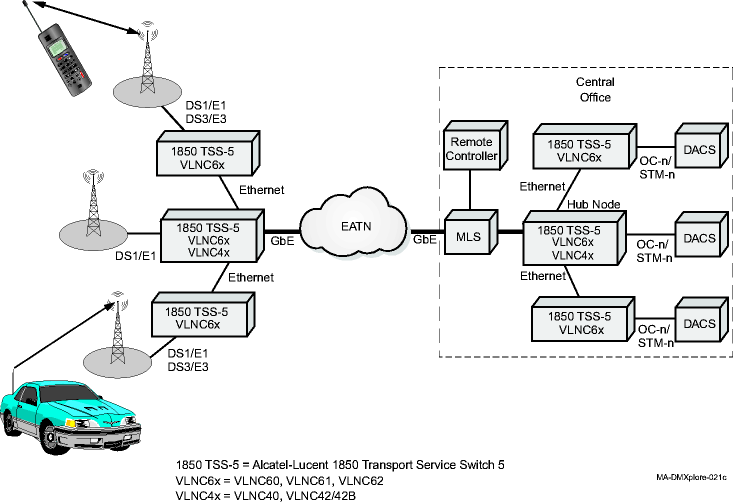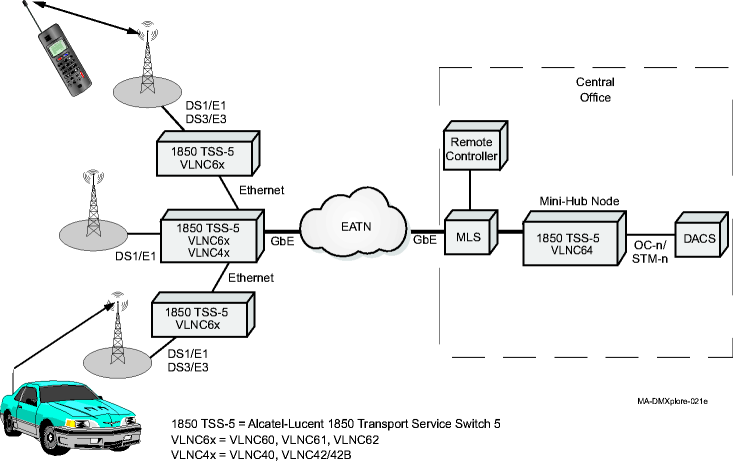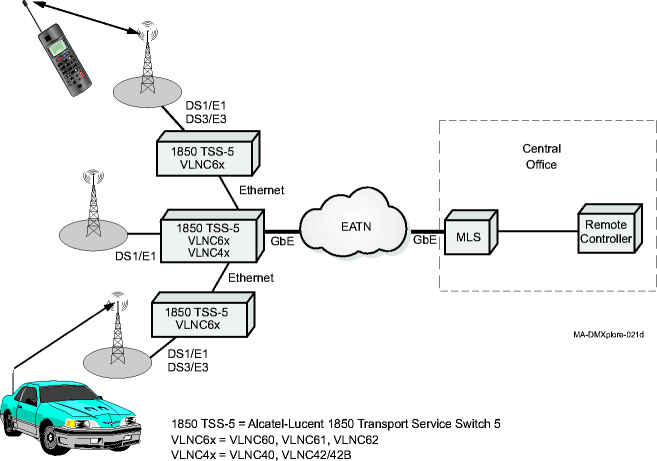Wireless backhaul
Overview
Alcatel-Lucent 1850 TSS-5 supports circuit emulation to provide backhaul for wireless voice and data, from next-generation Ethernet-based mobility equipment (BTS, NodeB) or T1-based legacy equipment, over a packet-based Ethernet network.
Wireless voice backhaul
Circuit Emulation is required to preserve the context and nature of a circuit over a packet network. Circuit emulation on Alcatel-Lucent 1850 TSS-5 uses static pseudowires (no signalling or routing plane) within a configured pair of unidirectional tunnels to backhaul mobility TDM/ATM services over an Ethernet network.
Figure 3-3, Wireless voice backhaul (VLNC60/61/62 circuit packs at both ends) shows an application using Alcatel-Lucent 1850 TSS-5 shelves equipped with VLNC60/61/62 Circuit Emulator circuit packs at both ends of the virtual circuit connection. The VLNC40/42/42B Ethernet Aggregator circuit pack can be used in the shelf to aggregate the Ethernet connections.
Figure 3-4, Wireless voice backhaul (VLNC60/61/62 and VLNC64 circuit packs) shows an application using Alcatel-Lucent 1850 TSS-5 shelves equipped with VLNC60/61/62 Circuit Emulator circuit packs at the remote sites and the VLNC64 Circuit Emulation Mini-hub circuit pack used as a hub at the opposite end of the virtual circuit connection.
Figure 3-3: Wireless voice backhaul (VLNC60/61/62 circuit packs at both ends)

Figure 3-4: Wireless voice backhaul (VLNC60/61/62 and VLNC64 circuit packs)

Wireless data backhaul
The VLNC60/61/62 Circuit Emulator circuit pack can also provide ML-PPP Layer 2 termination service to reduce bandwidth requirements for wireless data backhaul. In this application, the incoming DS1/E1 signals contain Ethernet data in ML-PPP links, which are terminated by the VLNC60/61/62 circuit pack. The VLNC60/61/62 circuit pack uses 802.1Q encapsulation to transmit the IP traffic directly over the packet network. It interworks between the DS1/E1 ML-PPP links from the BTS Universal Radio Controller (URC) and Ethernet links running 802.1Q encapsulation towards the MSCs.
Figure 3-5: Wireless data backhaul

Application advantage
Mobility backhaul networks are moving from circuit switched to packet-based (Ethernet, IP/MPLS) technologies. Alcatel-Lucent 1850 TSS-5 uses circuit emulation to provide backhaul for wireless voice and data, from next-generation Ethernet-based mobility equipment (BTS, NodeB) or DS1/E1-based legacy equipment, over a packet-based Ethernet network. It preserves the context and nature of a circuit over a packet network, and allows wireless providers to preserve their investment in the remote and hub equipment (BTS/NodeB and edge router or RNC/MSC).